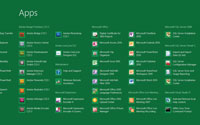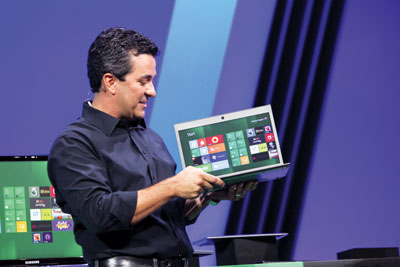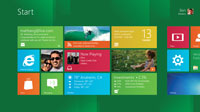In-Depth
Top 8 Partner Opportunities in Windows 8
- For more Windows 8 news as it happens, visit the Windows 8 section on our 2011 Microsoft Product Roadmap.
In the last few months, the amount of detail available on "Windows 8"has grown exponentially. With a developer preview of the OS in the field, the sessions at the recent BUILD show and extensive blog posts, Microsoft is putting a lot of information out about its next OS.
The need for information this time is much greater than in a typical Windows upgrade. Microsoft is responding to radical shifts in technology usage with what looks like an equally radical shift in its flagship OS. Windows 8 will run on tablet devices with system on a chip (SoC) architectures as well as x86 systems, have a touch-first interface and sport a tile-based look that represents the most significant UI change in a single product generation than anything Microsoft has introduced since Windows 95, if not earlier.
For now, Windows 8 is primarily a developer story. As Steven Sinofsky, president of the Windows and Windows Live Division, said at the BUILD show for developers in Anaheim, Calif., in September, Windows 8 is "a new opportunity for developers -- a new opportunity for you to express yourselves and to get the most out of PCs, no matter what size or shape."

[Click on image for larger view.] |
| Right there on the lock screen for Windows 8, Microsoft is inviting development partners to "make awesome apps." Many of the channel opportunities around Windows 8 involve development. |
Many of the most heated debates at this point surround development questions. Of special concern are the different languages and application types that will be supported on the OS in its tablet and more traditional forms. There are also many questions about backward compatibility with applications designed for Windows 7 and earlier versions of the OS.
Even as these debates play out, the broad outlines of the opportunities for the entire Microsoft channel are beginning to become clearer with all the new detail about Windows 8. What follows are the top eight emerging opportunities for partners in the Windows 8 time frame (a time frame, which, at the moment, is not clear). Because many Microsoft partners are developers or offer development in their portfolios, we'll start with those opportunities. After that, we'll look at more solution provider-oriented opportunities.

[Click on image for larger view.] |
| Migrating corporate applications to Windows 8 should be a big business for custom development shops. |
1. Custom App Development
Windows 8 brings a new type of app to the Windows desktop ecosystem. The UI for the apps is called "Metro."It looks familiar to anyone who has used a Zune player or a Windows Phone, which is to say that it's not familiar to many end users, but it will be familiar to a large percentage of Microsoft partners.
More broadly speaking, the apps take advantage of new Microsoft development tools and are capable of appearing on a new tile-based Start screen paradigm, where they have limited space to display real-time information. At this point, it looks like the Metro approach will be ideal for lightweight apps that are obviously similar to the types of apps that run on an iPad.
Partners involved in custom application development will need to spin up practices around the creation of Metro apps for customers' internal corporate applications. This work will go hand-in-hand with discussions about the devices that customers will want to use (more on that later), creating a partner-to-partner business opportunity with solution provider partners.
Because of the highly complex matrix of development language and application-type compatibility questions that are emerging around the different platforms -- Windows 8 tablets, Windows 8 PCs, and Windows 7 and other legacy PCs -- even customers with in-house development teams will be looking for guidance from partners who can help them navigate to the right combination of devices and apps.
Partners with expertise at developing clean, creative and highly productive Metro apps that leverage the capabilities of a Windows tablet will find themselves in high demand from two sides. One will be customers looking for competitive advantage for their businesses. The other side will be Microsoft, which can be expected to lavish attention and resources on partners that can provide the proof points that all the platform bets it's placing have real business value.
There are two other aspects of custom app development that stand out as especially novel opportunities. One is the chance to develop multi-device apps on the Windows platform that present only the appropriate capabilities for the desktop user, the tablet user and the smartphone user. The other is the opportunity to create cloud-connected apps that tie the expanding cloud infrastructure to the mobility provided by the tablet form factor.
 |
| Michael Angiulo, corporate vice president of Windows Planning, Hardware & PC Ecosystem, shows devices at BUILD. Customers will need more help than in the past in selecting devices that meet their business needs. |
2. Porting Corporate Apps and Web Sites
With the new Start screen approach, which is the biggest change to the desktop since Windows 95, nearly all applications, lightweight or heavyweight, will be tiled. As Windows 8 adoption grows, a partner business model can also be expected to emerge around porting existing corporate applications to Metro apps. This is a business that will overlap to a large extent with the custom app development opportunity, and in many cases a discussion about porting should lead to a deeper engagement involving development of a new or greatly improved app that takes advantage of the new platform capabilities.
The same goes for Web sites. Not only is Windows 8 a sea change from what went before, but it is accompanied by Internet Explorer 10, which is a touch-enabled browser. Customer Web sites will be due for significant overhauls to take advantage of the new capabilities or even to simply look up-to-date.
As the Microsoft Internet Explorer chief Dean Hachamovitch blogged, there's a lot of work for developers to do to take advantage of the new browser experience. "Touch is very important, and so is the immersive experience,"he wrote. "There's work ahead to make sure that sites that already run plug-in free for other devices can work that way in IE10. Similarly, some sites may need to update older, out-of-date libraries that don't work well with IE10. Including the current desktop style browser to deliver the compatibility that people expect from a Windows release is also important."
3 to 5 >>
3. Consumer App Development
Any partner who wants to see real hockey stick-like growth will want to at least dabble, if not jump completely, in the consumer app development world. The opportunity to create an app that any consumer would want greatly expands the addressable market.
Only time will tell if Windows 8 gains traction in its Metro form. But if it does, the shared Metro UI of Windows 8 and Windows Phone apps greatly improves the incentive for developers to target Windows Phone. The attraction is the same as the close link between iPad and iPhone development.
Where Windows has a potential advantage is when Windows 8 deployments become even a fraction of Microsoft's 1-billion-customer installed base. Suddenly apps that run on a tablet or the phone can also run on any desktop; the potential market for an app immediately becomes enormous.
4. ISV -- Corporate Solutions
Independent software vendors (ISVs) developing software for enterprise and corporate customers will have a lot to think about surrounding the Windows 8 release. Many of the opportunities that will present themselves to custom application developers (see No. 1) will be available to ISVs.
Where things may get really interesting for ISVs is around pricing. Windows desktop application development has mature pricing models. The introduction of potentially robust Windows app stores in the Windows 8 time frame -- along with the likelihood of lighter-weight apps -- does two things. It has the potential to completely transform Windows-based software sales and distribution while at the same time throwing a lot of the old pricing rules into chaos.

[Click on image for larger view.] |
| Tiles on the Start screen provide partners with a chance to push small amounts of real-time data to users in new apps or ported applications. |
5. Standard Migrations
There's been a premise in each of the last few upgrades -- Windows XP, Windows Vista and Windows 7 -- that this is the last major migration. The latest in that proud tradition came in August from Gartner Inc., in a news release predicting Windows 7 would run on 42 percent of the global PC installed base by year's end. "Gartner's forecast assumes that Windows 7 is likely to be the last version of Microsoft OS that gets deployed to everybody through big corporatewide migration,"the market research and analysis firm wrote.
Gartner provided three interesting points of support that probably make the statement more likely to be true this time than in the past:
"In the future, many organizations will also use alternative client computing architectures for standard PCs with Windows OS,"Gartner wrote in a reference to devices such as tablets. Gartner also cited the moves toward both virtualization and cloud computing as reasons there may not be a next major migration season.
Unmentioned by Gartner is a fourth point that supports the view. The Windows XP share is huge, Windows Vista is small and Windows 8 looks, thus far, potentially disruptive. That could amplify the attractiveness of Windows 7 as a corporate OS, extending its life in the enterprise and giving the other three trends time to gather steam.
While all that makes for a strong argument that the Windows 8 migration opportunity could be smaller for Microsoft partners than Windows 7 has been, some customers will want to make the move. The beauty of the Microsoft ecosystem from a partner standpoint is that no matter how small "some"is in percentage terms, in raw numbers it usually translates to "a lot."
And though it may seem a bit out of place in a discussion of Windows 8 opportunities for partners, the disruptive nature of Windows 8 will encourage a lot of customers to assume a wait-and-see attitude. The huge question is whether that wait-and-see group will be large, very large or consist of almost everybody. In any case, the Windows 8 release coupled with the pending end-of-life of Windows XP should extend the lifespan of the Windows 7 migration business opportunity.
6 to 8 (and extras) >>
6. Platform Guidance
Before migrating to Windows 8 or moving instead to Windows 7, many customers will need help from partners in arriving at a workable decision. All this choice in Windows 8 platforms is going to create a Wild West environment of compatibility. Organizations will need to navigate an extremely convoluted decision tree in determining how to go forward with Windows 8 version selection, hardware selection and application selection. Partners who thoroughly understand the variables, can clarify the decision tree and consult with customers on the best app migration platform should find their services in high demand.
This opportunity may be one of the first to materialize. For example, Microsoft executives have been talking up Windows 7 migrations as a good step for customers to get ready for Windows 8. While Microsoft's logic there is somewhat hard to follow, partners may also find a good niche in advising customers on new system purchases that will be compatible with touch capabilities in Windows 8 but that in the meantime are solid systems for running Windows 7 (or for exercising downgrade rights after Windows 8 ships).
As an example of the kind of information partners can be ready to share with customers, Microsoft revealed recently in a blog post which Windows 7 hardware the company has been using extensively to test Windows 8 capabilities -- the HP Elitebook 2740p and 2760p convertibles, ASUS EP121 tablet, Dell Inspiron Duo convertible, Lenovo x201 and x220t convertible and the 3M M2256PW 22-inch display. The same blog entry also listed nearly 50 other shipping systems that Microsoft had been using to test various Windows 8 features.
A big part of the discussions will be on an entirely new topic for most corporate customers -- tablets. To date, Windows tablet discussions have been vertical-specific discussions based on purpose-built devices. Since the launch of the iPad, many customers are eager to take a much broader view on potential business uses for the devices.
During an earnings call over the summer, Apple CFO Peter Oppenheimer said 47 percent of Global 500 companies were testing or deploying iPad.
"In the 15 months since iPad shipped, we've seen iPads used in the enterprise in ways we could have never imagined,"Oppenheimer said, according to a Seeking Alpha transcript. "Companies like Boston Scientific, Xerox and Salesforce.com are deploying thousands of iPads and revolutionizing how their sales teams engage their customers. iPad is being used inside the country's top hospitals like HCA and Cedars-Sinai and in retail at Nordstrom and at Esteé Lauder's Clinique counters. General Electric, SAP and Standard Chartered have developed internal apps for training, currency tracking and business process management to help make employees even more productive. And Alaska Airlines and American Airlines are using the iPad in cockpit to replace paper-based navigational and reference information pilots carry with [them] on every flight."
Broad corporate interest in tablets should be even stronger in the Windows 8 generation. Discussions on how tablets come into corporate settings will be intimately tied to discussions about available apps, custom app development projects, app porting projects and cloud capabilities.
7. Desktop Virtualization
Windows 8 will be the first client OS to include Hyper-V technology. Microsoft has included Hyper-V technology in the last two releases of Windows Server, and partners have increasingly found ways to leverage the virtualization technology for various solution scenarios. Hyper-V in Windows 8 will no doubt offer opportunities for partners, as well.
That said, Sinofsky set expectations in a recent blog post, writing that Microsoft is initially only looking to enable virtualization for a core set of scenarios for professionals. "The two most common scenarios we focused on are for software developers working across multiple platforms and clients and servers, and IT professionals looking to manage virtualized clients and servers in a seamless manner,"Sinofsky wrote.
In the same blog post, Mathew John, program manager on the Hyper-V team for Windows 8, discussed some limitations of the virtualization technology in the OS. "Features or applications that depend on specific hardware will not work well in a VM [virtual machine]. For example, Windows BitLocker and Measured Boot, which rely on TPM (Trusted Platform Module), might not function properly in a VM, and games or applications that require processing with GPUs (without providing software fallback) might not work well either. Also, applications relying on sub 10 ms timers, i.e. latency-sensitive high-precision apps such as live music mixing apps, etc., could have issues running in a VM."
Still, even with the limited use cases Microsoft is discussing so far, partners with virtualization practices will be watching closely for opportunities down the line to use virtualization to overcome legacy application incompatibilities or to create virtual desktop infrastructure solutions.
8. Training
To a large extent, the success or failure of Windows 8 will depend on how natural the UI is, and how easy it is to figure out and use. Yet, even if Microsoft does a superb job -- and early indications are that the UI is going to be very good -- user training will be a huge market for Microsoft partners. Any interface change is an opportunity for user training, and Windows 8 is billed as the "reimagining"of Windows.
One example of literally hundreds of changes is the addition of the Ribbon interface to Windows Explorer. The Ribbon will doubtless throw many users for a loop. Meanwhile, tips and tricks for storing and finding files, pinning apps and Web pages, rearranging the Start screen and using newly built corporate apps will all need to be explained. The iPad user base is primarily an early adopter, self-selected market. Its users are highly motivated to play with the devices and figure them out. Most of the corporate environment has a very different user profile, and they'll need classes and hands-on sessions.
With the release anywhere from eight months to more than a year away (Sinofsky declined to provide a release target), partners have a lot of time to get ready for Windows 8. But this is a disruptive release, and many of the opportunities reflect that. The sooner partners start thinking about ways to build business around Windows 8, the stronger that business could be.
About the Author
Scott Bekker is editor in chief of Redmond Channel Partner magazine.